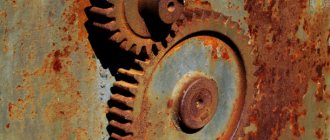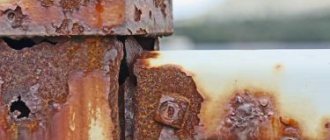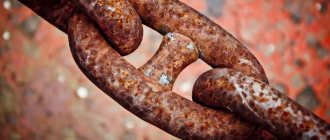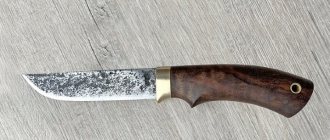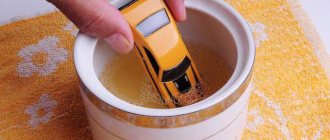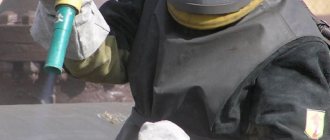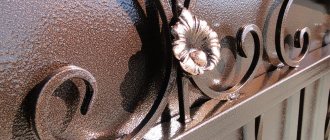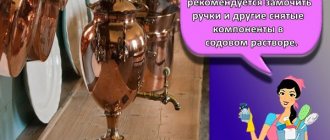Metal surfaces are often subject to corrosion for many reasons - from contact with humidity, other metals, and aggressive environments. There is a danger regardless of the place of use - both indoors and outdoors.
In this material we will look at the main methods of dealing with this problem and ways to remove corrosion that has already appeared. This will allow you to apply a protective coating or inhibitor on top, which will significantly extend the life of the steel part.
Manual processing as an effective method of combating corrosion
The main feature of the manual method is that during the cleaning process special tools are used without connecting to an electrical outlet. Usually this method alone is not enough to cope with rust, so additional means are used.
If you want to remove corrosion products, you can use a wire brush, spatulas, or sandpaper with coarse abrasive. Hammers help fight dense deposits.
Corrosion Damage
The type of corrosion damage depends on the material of construction, the presence of non-condensable gases, and the method of collecting and discharging the steam condensate.
Carbon steel
For carbon steel (CS) equipment, the presence of oxygen in the condensate typically creates pits that are often filled with corrosion products.
The presence of CO2 creates a mesoid type attack or deep groove. Corrosion products are often carried away with the escaping condensate and can settle elsewhere in the system where the flow rate is lower or the pressure is reduced.
Copper and Nickel
Copper-nickel heat exchange tubes can suffer from flaking when thin layers of metal in the tube turn into oxides.
Oxygen is primarily responsible for this type of damage, but other gases such as CO2 and ammonia help determine the extent and morphology of corrosion damage.
The slight slope typically given to horizontal tubes in heat exchangers (with steam on the shell side) can encourage condensate to flow toward one side of the baffle or tube support plate. This localized flow can create deep grooves in pipes immediately adjacent to the baffle or support plate. Brass tubes are especially susceptible to this form of attack.
Mechanized metal processing
When carrying out such cleaning, special installations are used. They are based on abrasive material or special scrapers.
The main advantage of processing using such material is that the equipment is equipped with a special electric mechanism. As a result, the process is significantly accelerated and the result becomes much better. The standard method for removing corrosive deposits is by rotating or reciprocating movements.
Why do metals break down?
When the non-condensable gases oxygen and carbon dioxide (CO2) are present in a system, alone or in combination, they can make hot condensate very corrosive.
These gases enter the steam-condensate system in several ways:
(I) together with boiler feed water in the form of “free” or entrained gases;
(ii) when steam condenses, a vacuum is created and air is drawn in;
(III) in the case of CO2 as a result of the thermal decomposition of carbonates and bicarbonates in the feedwater.
Other corrosive gases may be present in the steam and condensate system, including ammonia (NH3), hydrogen sulfide (H2s) and sulfur dioxide (SO2).
CO2 dissolves in water condensate to form carbon dioxide.
Consequently, the condensate will contain hydrogen ions (H+), which can promote corrosion. The presence of oxygen in the condensate leads to the following additional cathodic reactions, which can significantly stimulate the corrosive attack.
Removing corrosion using sandblasting method
This cleaning method is based on the use of a special installation, from which a stream of air containing abrasive particles is supplied under high pressure. Their uniform effect on the material helps to remove even fairly dense deposits without damaging the metal, gently preparing it for subsequent treatment with special protective compounds.
There are several basic working methods:
- Compressed air supply method. This method has already been described above in the most simplified way.
- Using moisture. In this case, in addition to the abrasive material itself, the air flow also contains small drops of water. This allows you to increase the severity of the impact.
- Wet cleaning. Instead of air, a water stream with abrasive particles is used. You can control the pressure yourself, as well as other indicators that directly affect the quality of material cleaning.
Corrosion damage
Corrosion usually causes losses because the destroyed metals require replacement.
This phenomenon can be observed in many industries:
- in energy
— chemical industry
— pulp and paper
— food
— in building heating systems
— corrosion can occur in steam consumers (for example, heat exchangers and reactors)
- in steam supply lines (usually in remote, cooler locations) and in condensate return lines.
Anti-corrosion chemicals
In modern industry, the practice of processing material using special chemicals is also common. Special compounds are used for high-quality surface cleaning even in complex products and hard-to-reach places.
Chemicals are often used when it is necessary to remove the remaining corrosion products after the bulk has been eliminated. At the same time, specialists conducting the procedure require a good understanding of how different types of compositions work with alloys that differ in their composition.
The process itself usually looks like this:
- Mechanical, manual or sandblasting is used. This allows you not only to remove most of the corrosion products, but also to naturally degrease the material.
- Application of a special substance. This is an aggressive composition, so processing should be carried out only in properly selected and worn personal protective equipment.
- Waiting for the effect. It takes 20 to 30 minutes for the composition to come into contact with the corrosion product and eliminate it. You can understand that the chemistry is working by the change in color of the rust coating itself - it becomes gray.
- Final cleaning. Water is supplied under sufficiently high pressure. All chemical residues must be removed.
After drying, the part will be ready for further processing to prevent the re-development of corrosion on its surface.
Anti-corrosion
Corrosion is the process of destruction of a metal during its physical, chemical or chemical interaction with the environment. It is divided into three types: - chemical (without the occurrence of electric current); — electrochemical (accompanied by a corrosion current); — mechanochemical (corrosion-mechanical wear, added friction, cyclic bending loads, vibration, etc.).
The car is mainly characterized by electrochemical corrosion. It is especially intense at relative air humidity of more than 60% and in a polluted urban atmosphere. Corrosion is caused by:
— weather conditions (rain, snowfall, temperature changes);
- pollution from acids and alkalis contained in the air, or salt sprinkled on roads in winter;
— the appearance in the metal after stamping and welding of areas with a changed structure;
— surface heterogeneity, as well as micro-inclusions of slag and small defects (shells).
According to the nature of its spread, corrosion can be continuous or local:
— a continuous one appears on the entire body, starting from the lower surface of the bottom, from the inside of the wings, and in the internal cavities of the doors and power elements (thresholds, cross members, amplifiers). Inside the cabin, it usually occurs under the floor mats;
— local occurs in places where metal sheets are joined by welding and rolling (edges of the hood and trunk lid, door perimeter). It is more dangerous than solid, as it flows faster, leads to through damage to parts and, as a consequence, to a loss of strength and rigidity of the body.
Galvanized body parts, although more slowly, also rust, especially in industrial cities. In hidden cavities, corrosion is invisible and therefore most dangerous. When the car moves on uneven surfaces, micro-movements occur in the weld seams of the body elements, reducing the tightness of the parts and destroying the previously applied protective film. Once rust appears on external surfaces, the process is irreversible.
The underbody of the car corrodes when the factory plastisol coating ages, peels off, and when moisture gets into the formed cavities. In addition, the protective layer is damaged by sand, small pebbles and gravel flying from under the wheels; it is torn off by accidental contact with hard objects - for example, icy snow accumulations in uncleared yards, protruding roots and fallen branches on forest roads, in ruts or when parking on sidewalk curbs.
The external paintwork of the body suffers from the effects of salt, acid precipitation, dirt and dust, ultraviolet radiation, and temperature changes (daily and during washing). The paint fades, oxidizes, becomes covered with scratches and cracks. As a result, the car begins to rust not only in hidden cavities, but also on the outside.
When to treat
At car factories, bodies are primed and painted, mastic (plastisol coating) is usually applied to the bottom, and protective compounds are applied to hidden cavities. Some body parts are galvanized. Sometimes manufacturers guarantee the time until through-body damage occurs. Nevertheless, it is periodically necessary to do additional anti-corrosion treatment. It all depends on the car:
— new foreign cars rarely require additional anti-corrosion protection after purchase. During operation, individual weak points are identified - you can consult both the car dealership and the anti-corrosion center about the advisability of their treatment;
— it is better to process new domestic cars completely and immediately. Factory anti-noise plastisols covering the bottom and wheel arches do not penetrate welds, do not contain corrosion inhibitors and only protect the metal from mechanical stress. In addition, the composition is applied before painting, having previously covered numerous threaded holes and studs with technological stickers. When assembling the car, they are removed, simultaneously exposing sections of the bottom. When transporting painted bodies and installing them on a conveyor, local damage to the coating is also possible. If the hidden cavities of the body are processed at the factory, a passport with a protection scheme and warranty conditions for it is usually attached to the operating manual. In this case, it is useful to contact an anti-corrosion center and check the completeness of application and the condition of the coating;
- used cars. It is recommended to periodically (every year or two) carry out complete anti-corrosion treatment. However, some anti-corrosion centers retain their guarantee if the owner of the car changes. Therefore, if the previous owner handed over the relevant documents, you can rely on their recommendations.
The frequency and volume of treatment depend on the operating conditions of the vehicle, the completeness of the previous anti-corrosion protection, the preparations used and the warranty conditions of the company that performed the work. In any case, it is recommended once a year, preferably at the end of summer, to visit an anti-corrosion center for a routine inspection and repair of minor damage to protective coatings. In addition, in the spring it is useful to thoroughly wash the car to completely remove any remaining de-icing compounds. Otherwise, in summer, at elevated temperatures and periodic wetting (rain, dew), the corrosion process is activated. At the same time, it is possible to notice and eliminate any defects in anti-corrosion protection. When replacing or repairing body parts after an accident, it is also necessary to restore anti-corrosion protection.
What to process
Conventionally, three generations of compositions are distinguished.
First: conservation, made from thickened oils with additives of corrosion inhibitors. These materials do not last long on vertical surfaces (doors, thresholds). They flow down, leaving a film that is unstable to mechanical stress and permeable to water vapor.
Second: film-forming inhibited petroleum compounds (PINS), which adhere well to the metal being protected. The waxy film mechanically insulates it from the atmosphere, and inhibitors block corrosion. Sometimes rust modifiers are contained; they restore the metal, turning corrosion products into an additional protective film about 100 microns thick, similar to soil. Often, an aluminum filler is introduced into the base of the compositions (the word “bronze” or gold is added to the names), it increases abrasion resistance and makes it difficult for aggressive ions (for example, chlorine) to penetrate. Recently, preparations with zinc filler have appeared; its particles, increasing the abrasive resistance of the coating, help slow down electrochemical corrosion.
Third: materials that contain water or highly purified oils instead of volatile petroleum solvents. Such compositions do not poison the atmosphere. Large manufacturers of anticorrosion agents produce a full range of compounds that differ in the degree of protection. All modern preparations are compatible with factory coatings, and anticorrosives of the same brand are compatible with each other. But it is not recommended to change the brand of the composition unless absolutely necessary. Even specialists at anticorrosion centers cannot always determine how the car was protected. Therefore, it is often necessary to remove the old additional coating from the bottom. And it is almost impossible to remove it from hidden cavities. Sometimes you can find out what a car has been treated with by looking at the sticker on the rear window.
Materials for protecting hidden cavities (ML-preparations) must:
— penetrates well into microgaps and cracks;
- be homogeneous and preferably thixotropic (the ability to adhere to vertical surfaces and set quickly);
— displace water and electrolytes from the metal surface;
— effectively impregnate corrosion products (rust);
- form an elastic film;
— do not have a harmful effect on the paintwork;
- have reliable adhesion (adhesion to metal).
Materials for protecting the underbody and wheel arches (UB-preparations) must:
— have high adhesion of the protective film to metal and factory coatings;
- have mechanical strength and abrasive resistance to impacts of sand and gravel, do not crack or peel;
— be elastic and withstand operating temperatures and mechanical deformations of the body;
- It is good to isolate the metal from aggressive electrolytes.
Anti-gravel protection materials must protect the factory paintwork from the intense abrasive effects of sand and gravel. This is another processing step. Anti-gravel agents often contain polymer components to increase durability.
Paint protection materials penetrate into the pores of the paint and provide additional protection. They must be water-repellent, UV-resistant and contain corrosion inhibitors.
The main stages of complete anti-corrosion treatment:
— washing the car from below with hot (60–80°C) water under pressure up to 60 atm with the fender liners removed;
- drying.
However, modern anti-corrosion materials displace water, so they can be applied to a damp surface;
— inspection and troubleshooting (some anti-corrosion drugs glow blue under ultraviolet irradiation);
- application of drugs.
There are two ways to access the “labyrinths” for processing: with and without drilling additional holes. As a rule, the first method is used. The second is much less common, because almost all cars have inaccessible volumes that require special equipment to process; — after application, the preparations gradually (about a day) set. During this period, it is better to refrain from operating the car. When forced to travel through snow, water, dirt and gravel roads, you must move carefully. In addition, you can drive a car with a catalyst no earlier than three hours after treatment. The car cannot be washed for a week.
Where to do
As a rule, an anticorrosion center is chosen based on the recommendations of friends or based on one’s own experience. The last method is the most correct, because the quality of the work is confirmed by time. In addition, a good company has indirect distinctive features:
— positive reputation, work experience and official representative status (direct supplies of anti-corrosion compounds);
— the opportunity to familiarize yourself with the list of work performed and technological maps (schemes) for processing vehicles;
— certificates of specialist training and company certification;
— a complete set of equipment for all types of processing (main types of nozzles for spraying drugs);
— cleaning and washing the car immediately after treatment or, if provided for by the technology, after a certain period of time;
— competent staff answers to questions about the purpose of the materials used and their differences, the essence of processing, etc.;
— a guarantee for the safety of the body and its preventive maintenance, the conditions of which are detailed in the relevant document.
Do-it-yourself anti-corrosion treatment
Let's say right away that it is better not to do this: self-treatment is less effective than that done in an anti-corrosion center, where special equipment and well-established technology are used. But if you still decide to do the processing yourself, then it is useful to consider that:
— it is not recommended to reduce the amount of preparatory and main work by skipping individual stages;
— it is advisable to reproduce as much as possible the conditions and processing modes adopted in anticorrosive centers;
- the benefits of “folk” remedies (mining, gun fat, bitumen, shale mastics) are small - they do not contain inhibitors, create a greenhouse effect and can peel off the factory plastisol coating;
— modern preparations sold in aerosol packaging are intended only for minor repairs of the corresponding anti-corrosion coating. They have a low concentration of protective material - no more than 30%. The remaining volume is occupied by solvent and propellant;
— it is advisable to use formulations identical to those used in anti-corrosion centers, but packaged in small-volume containers (so-called Euro-cylinders with a capacity of 1 liter).
When purchasing drugs in a store, you need to pay attention to the accompanying information. It should contain:
— information about the manufacturer (company name, address, contact numbers, etc.);
— characteristics of the drug: name, purpose, color, consistency, type of solvent;
— standard or specification number, date of manufacture, shelf life, batch number;
— technological application features: type of surfaces to be treated and their preparation, effect on paint and varnish coatings, method of application and removal, temperature ranges of treatment, drying modes, thickness of dry and/or wet film, number of layers, drying and holding time before use, consumption;
— precautions for storage and use, urgent measures in emergency situations.
How to prevent corrosion
To reduce the costs of directly combating corrosion, it is most convenient to think in advance about how to prevent its development. And for this purpose several methods can be used at once:
- Preliminary high-quality processing of the material. Can be done by polymer coating or galvanizing. The second option is preferable because a protective layer is formed on the metal surface, and contact with potential sources of oxidation is completely eliminated.
- Application of methods of protection against external and internal risk factors. These include both contact with various corrosion catalysts and aggressive environments, and the exclusion of proximity to metals capable of forming electrochemical corrosion.
- Fight against existing corrosion. It looks like removing the layer that has already appeared using the methods described above, as well as subsequent treatment of the damaged area with protective compounds.
Next, we will take a closer look at ways to combat corrosion both in industrial and home environments.
Protective methods for the car body:
- 1.anaphoresis (passive) - the surface is covered with a primer and then paint. Regularly check the integrity of the protective layer to ensure that there are no cracks or chips. It is also recommended to wash the car at least once a week and regularly wax the surface;
- 2. cataphoresis (active) - treatment with special protective agents (mastic, anti-corrosion materials, sealants) of the most susceptible to corrosion parts of the vehicle body (sills, arches, bottom). Apply exclusively to a clean and dry surface;
- 3.galvanization (electrochemical) - body parts are coated with a layer of galvanic zinc, which reacts chemically with the metal surface. The result is a reliable protective coating that is resistant to corrosion.
The types of protection differ in the priming method and complement each other. Reliable - galvanized, but also expensive.
Methods for eliminating corrosion in industry
Today, several products are used at once that allow you to deal with rust as effectively as possible. These include:
- Special converters. They allow you to turn the corrosion product itself into a special product, a coating that provides high-quality protection in the future.
- Exposure to acids. For treatment, hydrochloric or sulfuric acid combined with an inhibitor providing this possibility can be used. Up to 5% sulfuric acid is usually added to the solution. Hexamine would be a good inhibitor option for this treatment method.
The use of lactic acid and petroleum jelly is also common. The main thing is that the specialist has a good understanding of the features of the specific type of inhibitor and its combination with different active substances.
Traditional methods of fighting rust
1. Acetic acid
You can dip the item in vinegar or treat the item with a spray bottle.
You will need a 70% preparation, essence or regular vinegar. Take a container the size of the corroded product and pour acid into it. Dip the rusted element into the liquid and leave for 2-3 hours. After this, take out the product and enjoy the result.
If the damaged surface covers a large area, apply spray treatment. Pour acetic acid into a spray bottle and spray onto the rust. Be sure to wear safety glasses to prevent eye burns. Upon completion of cleaning, dry the product and apply an anti-corrosion agent to it.
2. Soda
Mix baking soda with water and use an old brush to scrub the dishes.
The food product will help spot neutralize rust. Soda is suitable for cleaning kitchen utensils, utensils, and various mechanisms. If necessary, the procedure can be performed several times. Mix baking soda with water until a paste forms. Apply the resulting mixture to areas of corrosion and rub thoroughly with an old toothbrush. Leave the product on for a couple of hours and then clean the surface.
3. Citric acid
The more concentrated the acid, the more effectively corrosion is removed.
An effective remedy for getting rid of corrosion in hard-to-reach places. Be sure to wear protective gloves while working. The more concentrated the citric acid, the more effectively the corrosion is removed. Dilute 80 g of powder in 100 ml of warm water and pour the resulting liquid into a container. Soak the part in the cleaner for a couple of hours.
4. Oxalic acid
Acid will remove not only rust, but also other contaminants
The acid is quite caustic, so do not forget about protective equipment. The substance will help remove rust and other contaminants on the metal. The part must first be washed and dried. Next, prepare a solution of 6 tsp. oxalic acid powder and 300 ml of water. Dip the item into the liquid and leave for 30 minutes. After the allotted time, remove the product and remove any remaining rust with a toothbrush.
5. Hydrochloric acid
A 2% hydrochloric acid solution will be sufficient
It is enough to wipe the corroded areas with 2% hydrochloric acid until the rust dissolves. It is also necessary to follow safety precautions.
6. Hydrogen peroxide
Peroxide is best used together with sodium salt
Option for cleaning plumbing fixtures, toilets, bathtubs and cutlery. Best used in combination with trisodium phosphate. Dissolve 4 tbsp. sodium salt in 3 liters of water and add 50 ml of hydrogen peroxide to the liquid. Wipe the rusted areas with the resulting product.
7. Coca-Cola
Cola copes well with rust in the initial stages
Sweet soda contains phosphoric acid, which also helps remove rust. You will need a container of the appropriate size and enough cola to dip the product into. Exposure time - 12-20 hours. Then rinse the item and dry it. You shouldn’t expect a phenomenal effect from soda, but it will cope with a mild form of rust.
8. Sandpaper or foil
Food grade foil works well against rust on plumbing fixtures
Sandpaper can be used to mechanically remove corrosion. It is enough to treat the damaged areas to remove the rust. Ordinary food foil is also suitable as an alternative. Roll aluminum paper into balls and rub them on the corroded areas.
Mechanical cleaning methods
The choice of a specific cleaning method is determined by the type of metal surface being cleaned. For example, for a coil of steel wire that has been stored for a long time, you can periodically rewind it from one pair of rollers to another. In the process of such bends, first peeling occurs, and then separation of scale from the metal surface.
After such rewinding, it is better to finally pass the wire between a pair of hard steel brushes, with the help of which the rust is finally separated from the base metal. Removing rust in this way is also possible if you use sandpaper or coarse paper instead of brushes.
The disadvantage of this method is that after processing, traces of the cleaning tool remain on the cleaned surface.
After mechanical cleaning, metal products should be polished, especially if the surface being treated should retain its original appearance.
